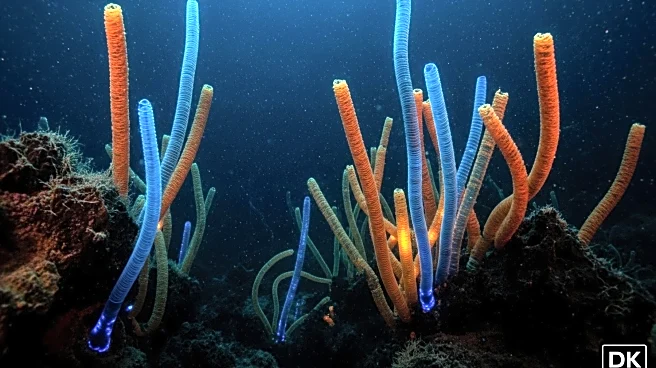What's Happening?
A recent study published in PLOS Biology has revealed the survival strategies of Paralvinella hessleri, a species of worm thriving in the harsh environment of the Pacific Ocean's hydrothermal vents. These vents, characterized by boiling water and toxic gases such as hydrogen sulfide and arsenic, are typically inhospitable to most life forms. Led by Dr. Hao Wang, the research team utilized a remotely operated vehicle to explore these depths, discovering the bright yellow worms against the dark vent landscape. The worms have evolved to detoxify arsenic and hydrogen sulfide, using sulfur from the water to form a non-toxic mineral called orpiment, which also gives them their distinctive color.
Why It's Important?
The discovery of Paralvinella hessleri's survival mechanisms offers significant insights into biological adaptation in extreme environments. Understanding how these worms detoxify arsenic and hydrogen sulfide could lead to advancements in environmental remediation and medicine. The ability to replicate these natural detoxification processes could provide new methods for dealing with environmental toxins, potentially benefiting industries focused on pollution control and public health. This research highlights the potential for biological solutions to address human challenges in managing toxic substances.
What's Next?
Further research is needed to fully understand the molecular mechanisms behind the worms' detoxification processes. Scientists aim to explore the biological pathways involved in the absorption and processing of sulfur and arsenic. This could lead to the development of new technologies or methods that mimic these natural processes for use in other organisms or applications. The study opens avenues for interdisciplinary research, combining biology, environmental science, and technology to address complex ecological and health issues.
Beyond the Headlines
The study of Paralvinella hessleri not only contributes to scientific knowledge but also raises ethical and environmental questions about human interaction with extreme ecosystems. The potential to harness biological processes for human benefit must be balanced with the preservation of natural habitats and biodiversity. As researchers delve deeper into these mechanisms, considerations of ecological impact and sustainability will be crucial in guiding future applications.














